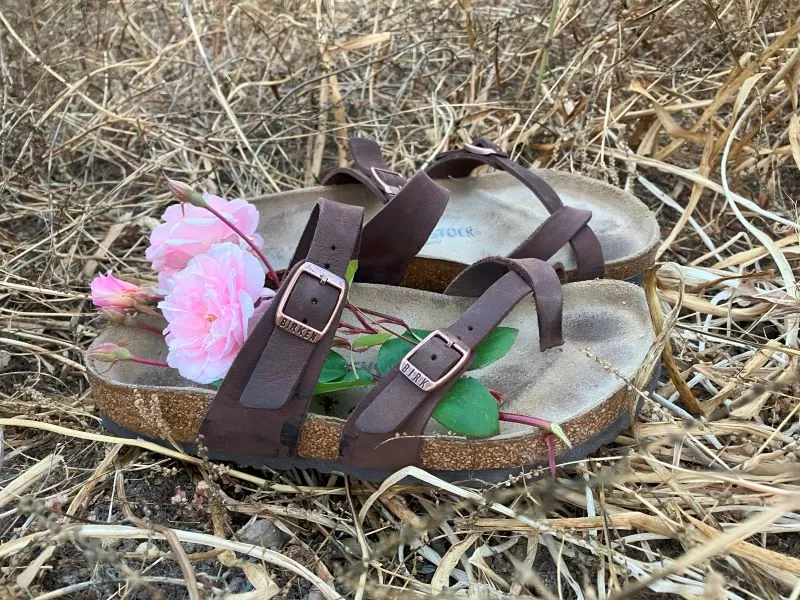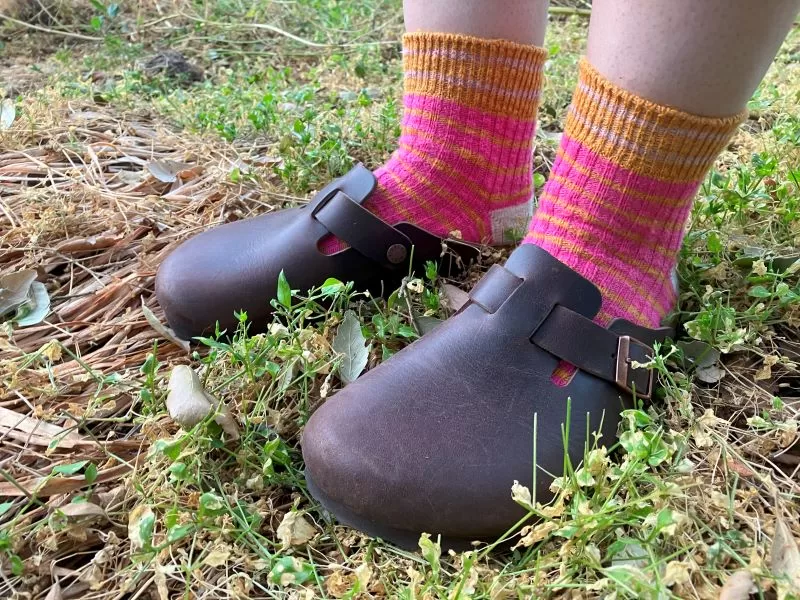
“Crunchy Topanga hippies wearing their Birkenstocks,” conjures an image of a Topangan, anywhere from 1966 through the present day, enjoying life in comfortable shoes.
I’m sitting here next to the editor of TNT as I write this introduction. I’m wearing thick wooly socks and Birkenstock Boston clogs in oiled leather in the shade “habana.” I’m drinking my peppermint tea and enjoying how comfortable my feet are. How glad I am to finally have shoes that don’t make the bones in my feet ache.
Anyone who’s had an ill-fitting pair of shoes, or who has orthopedic issues knows the struggle of foot pain, and since 1774 Birkenstock has sought to address that issue.
Birkenstock’s long history begins in the late 18th century, with Johann Adam Birkenstock, who, in 1774, was “listed as ‘subject and cobbler’ in the church archives of Langen-Bergheim, Germany,” according to the Birkenstock USA website. Johann’s grandson, Konrad, continued the cobbling tradition, and in 1896, he began crafting and selling flexible footbed insoles. Six years later, Konrad conceived the first contoured arch support, designed to mimic the natural curvatures of bare feet. Konrad theorized that if footwear had a base that matched and supported the organic footbed shape, it would offer greater comfort than flat footbeds, which, until then, were the industry standard. In 1925, a recently opened factory in Friedberg, Germany, manufactured Birkenstocks signature “blue footbed” shoe inserts. Konrad’s son, Carl, launched the “Carl Birkenstock System,” and Birkenstock training courses in 1932.
This year, we celebrate the 60th anniversary of Birkenstock’s original shoe style, the single-strapped Madrid. Introduced to the United States market in 1966 by German-American dressmaker Margot Fraser, Birkenstocks quickly became associated with the counterculture movement of the 1960s and 70s. The end of the Cold War was appropriately marked by the arrival of the Boston clog in 1977. A shoe synonymous in culture with peace, love, and foot comfort, it celebrated its 45th anniversary last year.
Birkenstocks have since enjoyed major renaissances in the fashion realm such as the “Docs and Stocks” mania of the 90s, and their current status as the “It Girl shoe,” first with the two-strap Arizona model and now with the highly-coveted slip-on Boston model. Known for being comfortable, durable, and trendy, Birkenstock has managed to make orthopedic shoes cool beyond irony.
In terms of women’s footwear, Birkenstocks were a natural choice for the counterculture movement (Topanga hippies included), given the stark contrast of the comfy, clunky shoes against their rigid and refined counterpart of high heels. In the post-WWII era, gone were the days of sensible leather loafers for the factory and homefront. During the 50s and 60s, American women had been squeezing their feet into pointy-toed kitten heels and stilettos à la Doris Day and Jackie Kennedy. The modern woman of the mid to late 1960s wanted shoes she could comfortably live her life in, without the pains of blisters and bunions.
Consumers should be aware that Birkenstocks come in several different footbed options. Their signature blue cardboard box is emblazoned with the slogan zwei weiten fur die perfekte passform, or “two widths for the perfect fit,” indicating their two width options: medium/narrow (indicated by a solid footprint icon) and regular/wide (indicated by a footprint silhouette). The shoes also come in two primary footbed options: classic footbed (indicated by black lettering) and soft footbed (indicated by blue lettering), which incorporates a thin layer of foam padding into the classic footbed, though this option is noted for being slightly narrower than the classic footbed.

There are very few shoes available on the market that check all the boxes for consumers: adequate width, a supportive footbed, durability, and a stylish look. Birkenstock meets this need with unisex styles such as the Arizona and the Boston. However, recently, many of the chief complaints from consumers arise from Birkenstocks’ inconsistency in sizing. Their “regular/wide” width is not available in several of their styles, as many are offered only in “narrow/medium.” This cuts out a huge chunk of their potential customer base, as many foot pain-sufferers turn to Birkenstocks to accommodate their wide feet. Many women with wide feet struggle to find shoes in an adequate width. This is not an issue unique to Birkenstock, but an issue rampant throughout the footwear industry. Just as many women don’t want to squeeze themselves into clothes that are too small, many don’t want to squeeze their feet into too-small shoes in the name of vanity.
These criticisms come hot on the heels of the recent acquisition of Birkenstock by fashion powerhouse Moët Hennessy Louis Vuitton, or LVMH, who purchased a controlling share in the company, announced in March 2021, estimated at $4 billion USD. LVMH has been known for acquiring iconic publicly-traded heritage brands and often taking them private, as in the recent case of Tiffany and Co. Many fans have cited concerns that the Birkenstock brand will stray from its roots as an orthopedic shoe company and instead lean further into the fashion realm, trading comfort for trendiness. However, this new development has also brought about an interesting full-circle moment, as recently, Birkenstock has become more playful in their use of color and texture, adding new fabrics and colorways to their lineups. This recalls the earlier advice of Margot Fraser, who suggested that Birkenstock introduce a broader variety of colors, which, arguably, contributed to their success in the United States market. Americans love to be bold, and express themselves with their heart on their sleeve, er, sole. Could this be the beginning of yet another renaissance for Birkenstock? Fans eagerly await to see.
Earth-conscious consumers will be glad to know three of the major sustainability points of Birkenstock shoes. Aside from their signature leather, Birkenstock also offers their shoes in two vegan leather upper options: “Birkibuc,” a simulated suede, and “Birkoflor,” a simulated leather. Birkenstock’s signature footbed is made of cork, a natural material made sustainable by its renewable, recyclable, and biodegradable nature. Additionally, by having an upper made of durable materials, and a replaceable sole, many Birkenstock fans have proudly claimed to have their pairs for multiple decades, getting them resoled and patched as needed. With such a long lifespan, a single pair of Birkenstocks can keep several other pairs of sandals or shoes out of the landfill over the course of its use.
Birkenstock has pioneered a more comfortable shoe, leading the way for the footwear industry to follow suit. At the same time, the company has ingrained itself in modern culture and presents a significant impact to sustainability, feminism, and orthopedic fashions. Over the course of their nearly quarter-millenia history, Birkenstocks have come a long way, and fans eagerly await, with bated breath and curled toes, to see what will come next for the iconic brand.












